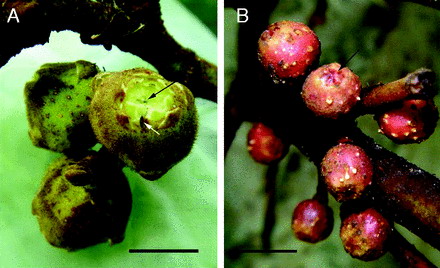Sympatric or sister taxa can provide powerful insights into floral scent-mediated reproductive isolation. Studies of the maintenance of pollinator specificity among sympatric closely related fig species rarely combine both behavioral and chemical investigations. Combinations of long-range floral scents, short-range contact cues and physical matching may act together to help ensure host specificity among fig wasps, especially among closely related fig taxa.
Dr. Wang Gang and his supervisor Dr. Chen Jin of Xishuangbanna Tropical Botanical garden (XTBG) used two sympatric varieties of an Asian fig tree, Ficus semicordata, that are host to two different pollinators, to investigate mechanisms of pollinator specificity among sympatric closely related fig taxa.
Both volatile and short-range contact cues were investigated and the following specific questions were addressed. (1) Are the floral scents emitted by receptive-phase figs of the two varieties distinct? (2) Do floral scents alone maintain pollinator specificity or are contact cues on the surface of the figs also utilized for host recognition by the fig wasps? (3) Do morphological barriers prevent entry into figs by the fig wasps associated with the other variety? (4) What are the reproductive consequences for the plants of being pollinated by fig wasps carrying alien pollen?
Their experimental studies were carried out using trees (and their associated wasps) that grow naturally in or around the XTBG (21°41′N, 101°25′E). Collection of volatiles, behavioral tests and other experiments were conducted from April to September 2011.
Their study showed that both long-range volatile attractants and surface cues contributed to host specificity in Ficus semicordata var. semicordata and F. semicordata var. montana, two closely related and frequently sympatric species of fig trees. Species-specific floral scents, the major mechanism for pollinator isolation in Ficus, were unable on their own to maintain the species-specific relationship between the fig wasps and their hosts. Contact stimuli from the surface of the figs played a complementary role in host recognition, but failed to ensure that pollinators only entered their typical host figs. Putative weak post-zygotic isolation between those figs species suggested that hybrid offspring production was likely.
The study entitled “The mechanism of pollinator specificity between two sympatric fig varieties: a combination of olfactory signals and contact cues” has been published online in Annals of Botany, doi: 10.1093/aob/mcs250

Receptive-phase female figs of (A) F. semicordata var. semicordata (FSS) and (B) F. semicordata var. montana (FSM)
(Images by WANG Gang)

